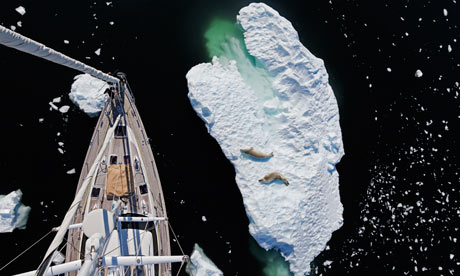Woman's missing digits grow back in phantom form
A woman born missing a finger and a thumb has grown them back – albeit as part of a phantom limb. This extraordinary occurrence shows that our brain contains a fully functional map of our body image, regardless of what our limbs actually look like.
The woman, RN, was born with just three fingers on her right hand. Aged 18, RN had the hand amputated after a car accident. She later began to feel that her missing limb was still present, and developed a "phantom" hand. "But here's the interesting thing," says Paul McGeoch at the University of California, San Diego. "Her phantom hand didn't have three digits, it had five.". |  |
Fusion: The quest to recreate the Sun’s power on Earth
Gaia Vince watches the construction of the world’s biggest fusion energy reactor and wonders whether this ambitious and expensive project will actually work.
Cadarache: In the dusty highlands of Provence in southern France, workers have excavated a vast rectangular pit 17 metres (56 feet) down into the unforgiving rocks. From my raised vantage point, I can see bright yellow mechanical diggers and trucks buzzing around the edge of the pit, looking toy-like in the huge construction site. Above us, the fireball Sun dries the air at an unrelenting 37C. These are embryonic stages to what is perhaps humankind's most ambitious scientific and engineering project: to replicate the Sun here on Earth. |  |
An eco-friendly building material offers potential as a replacement for cement

The construction industry is a significant contributor to greenhouse gases. Cement production alone accounts for five per cent of all global carbon dioxide emissions – that is more than the entire aviation industry. And the long-term trends are upwards: by 2020 it is estimated that demand for cement will increase by 50 per cent.
One answer to this problem could lie in a field of cannabis plants in Oxfordshire in the UK. Hempcrete is an environmentally-friendly building material made using fibres from a variety of the plant which is low in THC, the psychoactive chemical in cannabis. This fast-growing crop can lock up around 1.4 tonnes of carbon per tonne of hemp, making it carbon-negative. Buildings which use hempcrete can have a carbon footprint 20 to 40 per cent lower than those constructed using conventional materials.
Related Article: Hempcrete - Another Victim of the War on Drugs
One answer to this problem could lie in a field of cannabis plants in Oxfordshire in the UK. Hempcrete is an environmentally-friendly building material made using fibres from a variety of the plant which is low in THC, the psychoactive chemical in cannabis. This fast-growing crop can lock up around 1.4 tonnes of carbon per tonne of hemp, making it carbon-negative. Buildings which use hempcrete can have a carbon footprint 20 to 40 per cent lower than those constructed using conventional materials.
Related Article: Hempcrete - Another Victim of the War on Drugs
Tree's leaves genetically different from its roots
Black cottonwood trees (Populus trichocarpa) can clone themselves to produce offspring that are connected to their parents by the same root system. Now, after the first genome-wide analysis of a tree, it turns out that the connected clones have many genetic differences, even between tissues from the top and bottom of a single tree.
“The variation within a tree is as great as the variation across unrelated trees,” says Ken Paige, an evolutionary biologist at the University of Illinois at Urbana-Champaign, who led the team that made the discovery. |  |
Building Artificial Islands That Rise With the Sea
With an average elevation of just five feet above sea level, the Maldives—a nation comprising 1,192 islands in the Indian Ocean—is the lowest country in the world. Sea level, meanwhile, has risen by about seven inches since 1900, and scientists predict that it will rise as much as two more feet by 2100, pushing much of the population (about 390,000 and growing) out of their homes. In the past, engineers have used sand and rubble to create islands elsewhere, but these structures can disturb the sea and seafloor ecosystems.
|  |
Google patent calls on eyes to unlock smart glasses
In patent language, the application granted to Google this week says simply “Unlocking a screen using eye tracking information” but the message seems clear enough that Google plans to offer a way for wearers of Google headsets from its Project Glass to unlock their systems with just movements of their eyes. The patent describes a number of systems and methods for seeing to it that eye movements will cause the computing system to switch from being in locked mode of operation to unlocked mode, based on eye-tracking information.
|  |
The man who would die to go to Mars
As the Mars rover Curiosity approached Gale Crater earlier this week, Dr Pascal Lee was struck by the scenes from mission control. "There was this incredible atmosphere, even though the engineers were landing a robot," he says. "To me, it was a glimpse into the future: of that exciting moment when humans finally make the journey to the surface."
Excited as he is by Nasa's most ambitious mission to the red planet yet, this planetary scientist and explorer has long harboured more radical ambitions. Lee is chairman and co-founder of the Mars Institute, an international non-governmental organisation based at the Nasa Ames Research Center in California, which has the goal of advancing human exploration of Mars. |  |
NASA awards millions to new innovative advanced concepts
It's been a big week for NASA, but just because Curiosity is (incredibly) now safe on the surface of Mars doesn't mean that the agency gets to take a break. Instead, it's looking ahead. Far, far ahead, by funding 28 advanced technology concepts ranging from submarines for Europa to robots for the Moon.
The NASA Innovative Advanced Concepts program, or NIAC, is specifically designed to give a substantial amount of money to futuristic ideas that are so crazy that they'd never find funding anywhere else, but not so crazy as to be actually impossible. Or at least, that's what NASA would have us believe, but some of these things sound pretty wild, even to us. |  |
New Start-Up Aims to Fill Funding Gap for Space Projects
A new start-up company is hoping to ride the crowdsourcing wave to privately raise millions of dollars to fund scientific research, space exploration projects and other educational initiatives.
The company, called Uwingu (which means "sky" in Swahili), was founded by a team of noted astronomers, planetary scientists, educators and other industry officials. The idea was to create new ways for people to receive funding for innovative projects beyond the existing grants infrastructure. |  |
Mystery of how giant stars formed cracked

LONDON: An Indian-origin scientist and his team claimed to have solved the puzzle of how giant stars, 300 times the size of the Sun were formed, laying the theory that they are the result of collisions of two stars into a single ultramassive star.
Student investigates biochar for water treatment in developing countries
A variety of public health issues plague the refugees from Burma living on the Thai border, not the least of which is drinking water contaminated by bacteria and pesticides. Yet few low-cost, sustainable and appropriate treatment technologies are available to people in rural and developing communities to ensure water safety.
|  |
Dinosaur boom linked to rise of Rocky Mountains

The evolution of new dinosaur species may have surged due to the rise of the Rocky Mountains and the emergence of a prehistoric inner sea in North America, researchers say.
Duck-billed and horned dinosaurs flourished in North America, reaching a peak about 75 million years ago, a time known as the Campanian. For instance, one Campanian region known as the Dinosaur Park formation in what is now Canada saw seven different duck-billed dinosaur species and five horned dinosaur species emerge. A comparable region known as the Hell Creek formation in the United States from the Maastrichtian, the time that led up to the end of the Age of Dinosaurs 65 million years ago, saw only a single duck-billed dinosaur species and maybe three horned dinosaur species at most.
Duck-billed and horned dinosaurs flourished in North America, reaching a peak about 75 million years ago, a time known as the Campanian. For instance, one Campanian region known as the Dinosaur Park formation in what is now Canada saw seven different duck-billed dinosaur species and five horned dinosaur species emerge. A comparable region known as the Hell Creek formation in the United States from the Maastrichtian, the time that led up to the end of the Age of Dinosaurs 65 million years ago, saw only a single duck-billed dinosaur species and maybe three horned dinosaur species at most.
A New Species Discovered ... On Flickr
One day in May of 2011, Shaun Winterton was looking at pictures of bugs on the Internet when something unusual caught his eye.
It was a close shot of a green lacewing — an insect he knew well — but on its wing was an unfamiliar network of black lines and a few flecks of blue. |  |
Rate of Arctic summer sea ice loss is 50% higher than predicted
New satellite images show polar ice coverage dwindling in extent and thickness
Sea ice in the Arctic is disappearing at a far greater rate than previously expected, according to data from the first purpose-built satellite launched to study the thickness of the Earth's polar caps. Preliminary results from the European Space Agency's CryoSat-2 probe indicate that 900 cubic kilometres of summer sea ice has disappeared from the Arctic ocean over the past year. |  |
Wikileaks reveals “TrapWire”, a gov. spy network that uses ordinary surveillance cams
It's just like an episode of Person of Interest. According to documents leaked on Wikileaks, the government has created a piece of technology, called TrapWire, that siphons data from surveillance cameras in stores, casinos, and other businesses around the country. Apparently agents can use facial recognition software to analyze this footage for, well, people of interest. Are we living in a total surveillance state without even realizing it?
|  |
Vindicated: Ridiculed Israeli scientist wins Nobel
When Israeli scientist Dan Shechtman claimed to have stumbled upon a new crystalline chemical structure that seemed to violate the laws of nature, colleagues mocked him, insulted him and exiled him from his research group.
After years in the scientific wilderness, though, he was proved right. And on Wednesday (early today, NZ time), he received the ultimate vindication: the Nobel Prize in chemistry. The lesson? "A good scientist is a humble and listening scientist and not one that is sure 100 per cent in what he read in the textbooks," Shechtman said. |  |
Mystery Cloud in Mars Rover Landing Photo Solved
A strange cloud on Mars seen by NASA's Curiosity rover just after it landed on the Martian surface this week set the Internet buzzing over what it might be. Was it a dust storm? Part of the rover? Something a bit more … alien-y?
"We believe we've caught what is the descent stage impact on the Martian surface," Steve Sell, NASA's deputy operations lead for Curiosity's Mars landing, told reporters today at the Jet Propulsion Laboratory in Pasadena, Calif. "The fact that the descent stage flew directly aft of the rover was an amazing coincidence," he added. |  |
Archaeologists cover up Afghan heritage
BAMIYAN, Afghanistan — "It's there," says an archaeologist pointing to the ground, where fragments of a Buddha statue from the ancient Gandhara civilisation have been covered up to stop them being stolen or vandalised.
Just months before the US-led invasion in 2001, the Taliban regime shocked the world by destroying two giant, 1,500-year-old Buddhas in the rocky Bamiyan valley, branding them un-Islamic. More than 10 years on Western experts say Afghanistan's ancient Buddhist and early Islamic heritage is little safer. At the foot of the cliff where the two Buddhas used to stand 130 kilometres (80 miles) west of Kabul, an archaeological site has been found and parts of a third Buddha, lying down, were discovered in 2008. |  |


No comments:
Post a Comment